For the Borzoi breeder, there can be no dearer desire than to visit the breed at its home, to see and learn about it at work. These are incomparable teachings and memories, teachings that cannot be replaced by anything, memories that remain indelible and connect you to the breed more firmly than the largest breeding successes. The magnificent image of the large-scale Borzoi premises overshadow everything else that can be remembered for a lover of this magnificent breed.
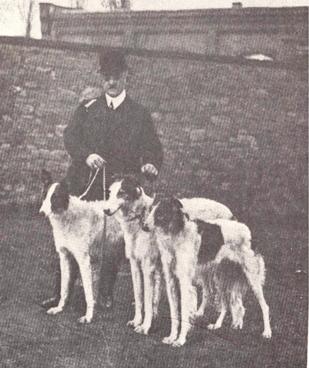
Only the hunter in the saddle can understand the lust for the chase and pay tribute to the Borzoi as a hunting dog. With muscles of iron and sinews like steel, trembling with excitement, at his post the dog tenses, waiting for the hunter to release the line, then shoots like an arrow over the most difficult terrain, knowing no obstacle and fear; no horse can hold the pace. Anyone who saw the Borzoi at work knows what the race is that sleeps in the boxes at our exhibitions, mourning the lost freedom of the homeland.
The actual hunt with Borzois as it is still practiced in Russia, resembles the chivalrous hunting style that was so popular in the splendid courts of France and Germany in the Middle Ages. It requires large and costly efforts, wide areas, rich material on dogs and horses, numerous guards and leaders, and is therefore reserved in Russia to only a few landlords.
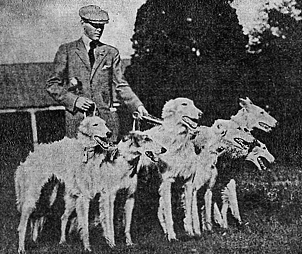
In 1904, when Mr. Thomas Jr., the well-known borzoi breeder in America, came across the ocean to study his favorites in their homeland and buy the most valuable material for his breeding, he graced us with his presence in transit from Paris to Moscow visits – then Leipzig – to get to know our breed, especially Nachal, who was still in the prime of his years. There was much to hear from the cynological conditions, from the “over there” hunts, and above all from the experiences Mr. Thomas had made on his last trip to Russia. Unfortunately, there were only short hours available, but they made a difference. The storytelling had given us the desire to travel, it gave us no more peace until we saw for ourselves and learned, and when the invitation came to Perchino, we were soon ready to travel ,
Perchino and Gatchina were the destinations of our trip, Perchino (pronounced Pértschino) in the Tula Government, with the idyllic hunting lodge of the Grand Duke Nikolaus Nikolayevich and his “classic” Borzoi kennel, the largest and most beautiful in the world; Gatchina), near St. Petersburg , with the magnificent, elegant kennel plant for the Borzoi people of the Czar.

Excellency von Waltzoff, with whom we had been in correspondence for some time, was just in Perchino, in order to make the final preparations for the imminent hunting visit of the Grand Duke, and had invited me to spend a few days there with my wife, to get to know the packs and the hunt. We chose the way over Warsaw, Moscow, Tula by train and then by ‘cars’ to Perchino. In Dankschau, Mr. Dankworth, the well-known and widely traveled representative of Spratt’s patent, joined us. He had been in Russia for his company many times, north and south, all the way to Siberia. From the rich treasure of his many-sided experiences, he was able to give us some useful advice, which kept us from some disappointment during the onward journey, and we still gratefully remember his companionship.
Warsaw was in a state of war. The double posts with attached side rifle on all street corners, in front of the banks and larger shops, made an uncomfortable impression, but apart from the visible readiness of the military and the early conclusion of some pubs, public transport was unaware of the tremendous ferment that later demanded so many victims. However, if you did not have to travel, you preferred to stay at home, the hotels were empty, the tourist guides complained.

After a short stay in Warsaw we continued the long journey via Moscow to Tula, day and night and again one day until late at night on the train. In Tula, waiting for us and sent by Mr. Waltzoff, we were met by a team of four at the station. It was an unfamiliar sight, four horses side by side, the middle ones the yoke team, the shapeless fat-dressed driver on the box, outspoken types of stately coachmen. In the incredible condition of the roadways, which are usually only remotely similar to a street within the villages, but are indicated outside only by wagon tracks, there is no other way across the country than with “fours” to get ahead, as we should soon realize.
The landscape becomes monotonous, only the ridge shortly after Tula is crossed, almost nothing but steppe, pasture, low wood, sparse deciduous forest, boring undulating terrain. Cultivated land moves only in meager strips of the poor villages, gloomy groups of low-rise log cabins. Usually there is only a single room in it for humans and livestock at the same time. Night guard figures squat in front of the doors, staring in front of Schmitz, the men all bearded, the long hair cut off at the nape of the neck, poorly dressed, their feet wrapped and tied with cloth, the women with rough faces, roughly of growth. Lazy and pious, dull as their lives are these people.
Behind the village the same monotonous picture of the steppe, far from home, no living creature to be seen. The coachmen do not say a word, just stupidly steer their horses. Only a series of deep furrows at swampy places holds 100 m wide show the way. The wheels sink to the right as far as the axles, and the ‘car’ sways like a stormy sea and crashes in all its joints, but the horses race on smooth ground and avoid the slippery furrows.

After a short break half way we went on at a brisk pace. The area remained monotonous and lifeless as before. No wild game could be seen around, a row of small farm carts was the only encounter. Strange are the axles of these cars, made of raw wood, they protrude on both sides about half a meter on the wheels out and protect so from tipping over, a caution that is very appropriate. The cart cannot grasp much. The small horses in the yoke team are willing animals – wiry and hard – usually having no care, no blanket, often no stable. What the soil carries by itself, must suffice as food. In autumn the farmer sells his horse, it is cheaper than food during the long Russian winter.
Over a hill and the picture becomes busier. White dots flash through the trees in the distance; we are correctly advised … it is Perchino. More and more clearly on the horizon emerges a stately building with a broad front, castle-like but simply built, idyllically situated in front of a wooded hill, next to it a chapel, all kept in white, and through the bushes shine even smaller block houses, also white, unadorned but clean and friendly, as if strewn to the slope. A lovely picture — here you can dream and rest in this seclusion of the world, far from the waves of life and the compulsion of duties.
Only the glittering band of a narrow river separates us, the wooden bridge roars beneath the swift hooves and finally we are at our destination! Apart from the castle and the chapel, the whole place consists only of farm buildings, civil servants quarters, large stables for the hunting horses and a group of fairly evenly built, cute log cabins for the pack and their guards.

For decades, the administration of this magnificent property has been under the supervision of Mr. Waltzoff. He comes here several times a year from St. Petersburg to prepare the hunts, test the services of the pack, and to meet the final arrangements for the stay of the Grand Duke, who is an avid friend of the hunts. He is personally and accurately informed about his pack so that his permission can be obtained from any sale of first-class animals that are not less than 1000 rubles.
The pack consists of hundreds of borzois and Russian bracken, which are nowhere to be found in the same quality. Mr. Waltzoff deserves the merit of having led the breed to such perfection. Among the Russian borzoi breeders, he is considered the most intimate connoisseur of the breed. With special love and understanding, he dedicated himself to the development of the entrusted packs. It is by this purposeful breeding we can thank the fact that the Borzoi of Perchino for decades has been the classic role model at the top. And it is not only on individual stars that this reputation is founded, but he has brought the whole pack to such a high level of development. He knows how to merge power and nobility, to cultivate the highest efficiency in the noblest forms and to keep it constant.
Right on the evening of our arrival, His Excellency knew how to captivate until the night and let the staff demonstrate best of the best, probably 60 to 70 dogs of enormous quality, as we have seen them individually, but in such great number , not even the Tsar in Gatchina can accomplish that. They were a picture, so wonderful, a balance in details, shaping full strength and thereby noble, clear bones, dry muscles, all with deep chest, firm stance, brilliant silky hair and head so racy and yet finely chiseled! And that was by no means the impression of a superficial revue, but an in-depth inspection of each individual dog. With a very special admiration, I still think of the generous judgement of Exellency Waltzoff, who made every remark, every instruction, no petting, overall appearance, type, substance and nobility. Such judgement is sublime about “might, should, should be” in the reports of our German judges.

The next morning was the visit of the castle, a veritable museum of hunting trophies and hunting paintings. Wolves of incredible size, with such colossal necks that it seems hardly conceivable for the slender Borzoi to have conquered such giants. In the large banquet hall, mighty bears are standing as candelabra in the corners, a peculiar sight. On the walls a whole gallery of Borzoi-portraits, mostly in whole figure, from all times, extremely interesting, paintings of ancestors of the Borzoi, a Tatar greyhound, pure as, very short-haired with wide flabby ears and most beautiful ring-tail, a rich collection for the explorer, the precious treasures of this world-remote castle, for the Hunter and the cynologists.

In the afternoon we went into the “kennel”, if one can still apply this expression to such size conditions. A huge terrain, like a drill place, is surrounded by friendly log houses. A small entrance leads to the camp sites of the dogs. Round planks of wood without intermediate walls, space for about 30 dogs. This is followed by the room for the keeper and the puppies, and continues in the room for females with their boys. Everything simple, but very practical and squeaky clean. In front of the house is the running room, where also the long troughs for feeding stand. It’s a pleasure to watch [the process]. In exemplary order all dogs enter the trough from the same side, the feed is poured in, but no one is stirring until the dog boy takes the cap, then they all go on it, but without bickering, well-bred. A magnificent picture, all of the same color, the hair patterned, a shining sight to see so much beauty together. Even with the selection, the most embarrassing care is placed on getting pure colors.
And so is a selection like the others, all colors separated, white with rust the custom, red, yellow, grey, all nuances, bright, dark, all colors – only white with black was missing entirely. Mr Waltzoff said that black was not a mistake, but it was not popular, only a matter of taste. However, when I think back to the wonderful shades of colour that were bred here, I have to give the master of breeding justice, such colours in contrast with black, which in fact, seems somewhat sober, and since that time I have never had these colors, at least In my own breeding, or liked.
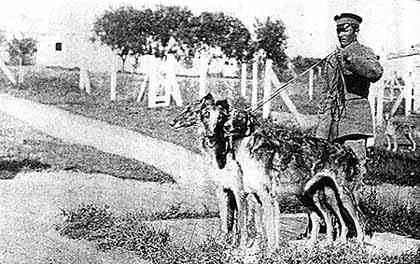
In Germany, we are still not so far away from reaching this colour ratio, and that is why I, as a judge, am absolutely far from wanting to reset a dog because of the colour, but it should be aspired to also I in the German at least to “pure” colors. Those who have seen these magnificent groups in Perchino will feel my growth. We now have the conditions so that all breeders fall on the one stud, which is just fashion, the famous champion, and thus the German breeding is unfortunately influenced far too unilaterally. I am convinced that a fairly healthy transformation would come if prima males were bred and sought from every colour, that would give a more versatile and certainly more successful breeding.
The rooms of the individual kennel departments at Perchina lead to a huge free space, anything like it not found even in Gatchina. Released, like lightning the dogs shot over the wide plain, a great, funny hunt, but a quiet wink of the keeper sufficed to collect the individual groups again, each dog knew where it belonged. What are German kennels against such dimensions? This is lacking for most borzoi in Germany, that wide, free space and the indispensable, impeccable appeal!
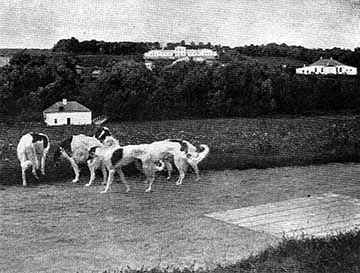
At the entrance of the enclosure lay carcasses of horses and dogs, as they are laid out to the wolves in freedom as a “Huss”. In the first moment, it is a strange feeling to be a peculiar nervous kid, so in the middle of it, even if you know how cowardly the animals are. shyly they crept behind the thicket, fled into the gorge, between the rocky rock at the flowing Bache and remained quite still, peering only cautiously behind the cover, secure, but when we were making an expression to come closer scurried up and away in such frantic haste that even the Borzoi would have trouble keeping the pace.
At this speed during the race to pack the wolf is not possible to catch on the hunt, but the Borzoi knows how to work, he tries to run the wolf from behind to thrust him with his nose into the hind so that he comes to topple, and then the paddock or zvora falls over him; the wolf fights desperately, the dogs often tearing whole pieces out of the fur, but soon he is defeated, as well as getting him to grasp the dogs in the neck. Meanwhile, the Hunter approaches and holds – when the wolf is to be caught alive – the hilt of the baiting whip in front of him, the wolf bites in blind rage, the leather is tied to the mouth and the wolf is trapped. This sounds much simpler than it actually is, because the wolf is a very dangerous opponent in the fight, in size he sometimes surpasses the Borzoi, his mighty bull neck is an even massive weapon and only the long strong pliers of the Borzoi can contain him. Occasionally there is a borzoi who has done with a wolf alone, but usually a coupling (2) or zvora (2 male and 1 female) is included. What we understand by “solo catcher” refers mainly to the hare-baiting, rarely to the wolf.

In winter, hunting is often carried out with sledges. The hunters mark places to lure the wolf, harmlessly over land-running peasants, and keep their dogs hidden in the sledge under blankets. The hungry wolves who have eyes on the horses are cautiously watching the sled from afar. The ride goes for miles, the horse, steaming without fatigue, follows the wolf with incredible stamina (it is known that wolves in a night go100 and more kilometers!) and only when he feels safer, the wolf dares to let him get closer, accelerates his run, increasingly brazen he comes up, until suddenly, in an appropriate place, on clear terrain, the coachman stops, lets the dogs out, and off the baiting goes with fresh forces, a short exercise – and soon they have captured the prey.
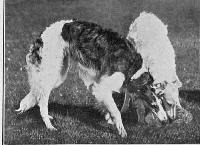
It darkened as our car blustered over the wooden bridge and we reached the castle again. Before dinner, Excellency of Waltzoff spoke the orders for the next day, horses, dogs and people were destined to go out to hunt, as to command output for a field service; it is something similar, a hunt with such a large apparatus of people and animals that belongs to it. After the splendid appetizer, in a genuine Russian way from the most varied, appetizing mushroom dishes and other delicacies with the inevitable vodka (from which you have already tolerated a good two to three glasses “before” tables), we sat down for dinner and an exciting conversation about the many new impressions of the day.

The next morning we went to the rendezvous place by car. The path leads to a beholding of the Prince Wloff [sic] passing through little diversified terrain, quite even, mostly only pastures, of little hardwood, mainly oak and birch stock, interrupted. After a trip of about 18 versts we arrived at the end of a village that was destined to be the rendezvous.
The hunters had long before us arrived with the dogs and had chosen an idyllic spot to rest. A very picturesque picture – the hunters sitting down, in Russian fur, blue cowl to the loins, the fang knife, with signal horn, and baiting whip – probably about 30 of them in number, along with the Borzoi and a pack of Russian Bracken with their houndskeeper.
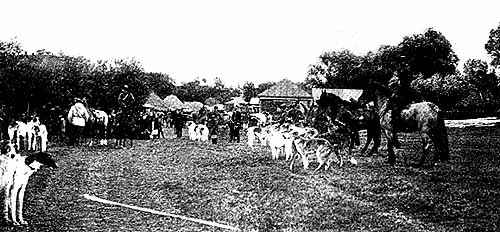
We did not tarry long and climbed to the horses; I rode a magnificent Goldfuchs of the Lord of Waltzoff. Soon the hunt was in the march. Advancing were the Brackenmeute, then the hunters, each with a zvora on the left side of the horse, all in military order like a squadron of Cossack. After a short march the two groups separated, the hunters waved with the borzoi off on the lateral heights, the Bracken remained straight. They had scarcely penetrated into a forest plot when their chiming sounded. We rode through the woods behind the Bracken on difficult, stony ground, but the horses stepped safely and we quickly got used to each other. This was now a search and haste, the Bracken trembling with zeal, a fresh, cheerful hunt. Further and further through the weld, the horses snorted and danced, could hardly be controlled, between trees and shrubs, up and down the hunt, soon louder, and soon fainter sounded the Bracken. Soon only isolated lutes still, as lifted the woods, went up to the height, the hunting sounded – a short stop! We had come near a village. In a wide circle, individual Borzoi were visible, which had previously been covered. On a second signal, the hunt went on to the other side of the village. We stayed at the height now to have a better overview. A few hundred meters from the village, the heights were again filled with Borzoi, and the Bracken were in the valley. Soon the cheerful chiming, the houndskeeper galloping, conducting the pack, with astonishing dexterity in the breakneck terrain; the Borzoi stood on their posts, the long heads protruded or proudly raised, as solidly standing, but jump ready, and now we also saw on the heights opposite individual hunters loosen the leash, the hounds storm in frenzied flight of it, putting out over trenches and hedges, hitting hooks, overtaking each other, vanishing from our gaze, then diving back up, a magnificent picture, so much playing power and agility and elegance! We are still excited and amazed, captivated by the gripping spectacle.
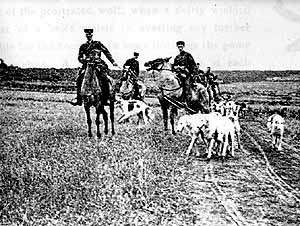
With beating hearts we turned and rode back in step to the village, expected at the exit with the car waiting. Here was the rallying point. From all sides, the hunters came with the dogs. At last, probably the last arrived, because at one time the colourful skein of dog and horse and rider, a proud parade of them moved past us with an uplifting farewell greeting: Waid Man’s salvation, your rider and hunter!
An unforgettable day was behind us, the fulfillment of a desire, cherished for years, to see the Borzoi in his homeland at work, in the work of great style, in the shining frame which only the chase can offer. This is hunting in the truest sense of the word “for your own sake”, the “stretch” verse disappears against the enormous effort, two bunnies and a fox was all, best to conceal, in order not to disappoint the reader accustomed to German game stock. The area is wildly poor, although the hunt is rarely practised, but the Grand Duke does not tolerate shooting in the vast areas, only rushing; however, lacking blood freshening, there are plenty of raids due to hungry peasants!
With an abundance of indelible memories we left Perchino on the following day. We were assured the promise of seeing Excellency Waltzoff quite soon as he was to judge at a German exhibition. We stowed the suitcases, said one last “Goodbye” and continued once again on our journey on the four-tracker the rough way back to Tula. As much interest as the journey over to Moscow and Petersburg would bring us, the glorious days of Perchino remained the culmination of the long journey.
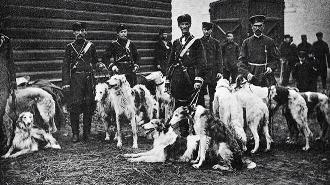
In Gatchina, not far from Petersburg, we saw the Tsar’s dog quarters. The kennels make a very luxurious impression compared to Perchino. Even the pitches, surrounded by elegant fences, lack the certain sober tone, as it has been understood that horticultural art around the long areas can be pleasantly interrupted by delightful groupings, everything is tastefully landscaped in the most attractive surroundings — a really dazzling frame for the Imperial hunt. For he who wants to create an elegant kennel, here is the classic role model! But for the dogs we prefer to choose the role model in Perchino. Maybe the dogs of the Tsar are as good in hunting as in Perchino, but that is difficult to determine, and that which elevates Borzoi to a truly royal race, seems to be missing in most of the dogs of Gatchina. Certainly it is interesting and instructive to have also seen this pack, but unequally valuable.
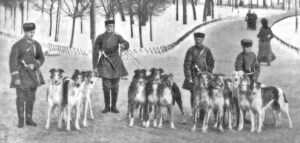
This article was published in the German Borzoi Studbook DWZ Volume 1 in 1910.
A Visit to Perchino, Tula Government by Dr A Wegener
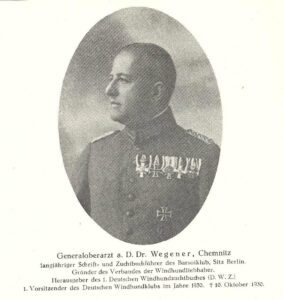
Published in The Borzoi Encyclopedia by courtesy of Evelyn Kirsch.
Translation: Sue Vasick
Photos added by: Dan Persson
Year of Event:
Country:
Personal Collections:
Source:
Author:
Dogs:
Persons:
